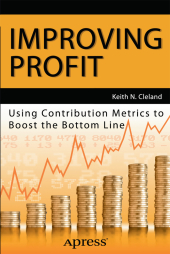 Neuerscheinungen 2014Stand: 2020-02-01 |
Schnellsuche
ISBN/Stichwort/Autor
|
Herderstraße 10
10625 Berlin
Tel.: 030 315 714 16
Fax 030 315 714 14
info@buchspektrum.de |

Keith N. Cleland
Improving Profit
Using Contribution Metrics to Boost the Bottom Line
1st ed. 2014. xii, 240 S. 2 SW-Abb. 254 mm
Verlag/Jahr: SPRINGER, BERLIN; APRESS 2014
ISBN: 1-430-26307-5 (1430263075)
Neue ISBN: 978-1-430-26307-4 (9781430263074)
Preis und Lieferzeit: Bitte klicken
Business of all sizes have a problem: How do you know-in real time-whether you are earning the profit you need to grow or even just stay in business? And which products or services are doing the "heavy lifting" in contributing to profit? Financial statements tell only part of the story. They are backward looking, for one thing, and they generally show results only in the aggregate. Worse, they never seem to reflect the hard work you´re doing on a daily basis. As one manager said, "If I´m adding 25% profit to every job, why am I getting barely 5% net profit at the end of the year?"
Improving Profit: Using Contribution Metrics to Boost the Bottom Line solves this dilemma. As this book shows, Contribution-Based Activity (CBA) measures focus on two key levers that are fundamental to the operation of any business: financial contribution and units of activity. Knowing how to use these levers gets your company off the treadmill and on your way to stellar profitability. And as the 21 case studies show, CBA is surprisingly easy to apply to businesses of all types and all sizes.
What is "financial contribution"? Simply the amount above and beyond the cost of goods or materials sold that contributes to covering overhead and creating profit. As entrepreneur, business consultant, and professor Keith Cleland shows, few managers actually know the financial contribution their products and services make, nor how to amplify that contribution by incremental adjustments to one or both levers. As you´ll learn, the financial tool Cleland created, TARI (Target Average Rate Index), provides insight into each product´s value. You´ll not only learn which products are contributing the most to the bottom line, but how to unlock the profit potential in run-of-the-mill products or services. Improving Profit will help you:
Restore and boost profit levels for your entire operation
Relate your daily efforts to a transaction´s actual profitability
Focus on the two key performance indicators that can help you identify and solve problems affecting finance and productivity
Help everyone in the company-from CEO to janitor-understand how their activities help or hinder the company´s fortunes
Make effective financial decisions
If you´ve ever wondered why your results don´t match your hard work, hopes, and dreams, read this book. As the case studies make clear, identifying and applying TARI results in a significant-and often dramatic-boost to the bottom-line.
Background to Contribution-Based Activity (CBA)
Kitchen Utensil Manufacturer Taken to the Cleaners
Printing Business Multiplies Net Profit by 500%
Furniture Manufacturer Climbs Out of the Red
Contractor Overcomes Competition to Make a Profit
Horticultural Equipment Proprietor´s Moment of Truth
Wholesaler Nets $2.5M in 10+ Months
Jeweler´s Changed Focus Turns Red into Black
Upmarket Café Learns How to Stay on Track
Diesel Repair Shop Rescued from Sand-Up- Hill Country
Garment Maker Multiplies Net Profit by 700%
Switchboard Manufacturer Climbs into the Black
Baker Identifies W here the Rubber Meets the Road
Architectural Practice Eradicates a Malignant Cancer
Accounting Firm Wins by Losing a Third of Its Fees
Legal Firm Transfers Productivity to the Bottom Line
Contractor Increases Strike Rate to 1 in 4
Hot Bread Baker Discovers More to Bread than Flour
Window Manufacturer´s Flawed Foundation
Multi-Home Contractor Discovers a New Way Home
Award-Winning Hairdressing Salon Cuts Its Way Out of Bankruptcy
Multi-Department Store Whitewashes the Past
14 Businesses Explore CBA/TARI
Questions Answered
Fast-Track Problem Resolution Guide
Definition of Terms
The Business Wheel
Epilogue: Why Contribution Metrics?


